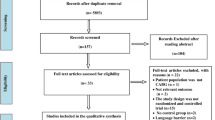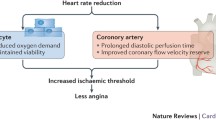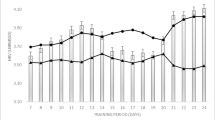Abstract
The aim of this study was to evaluate the influence of cardiac rehabilitation (CR) on heart rate variability (HRV) indices in men with coronary artery disease (CAD) treated with percutaneous coronary intervention (PCI) or coronary artery bypass graft surgery (CABG). The study population consisted of 131 male patients with CAD prospectively and consecutively admitted to CR after PCI n = 72, or CABG n = 59. Participants performed cycle ergometer interval training for 45 min three times a week for 8 weeks. At baseline and after 8 weeks, all patients underwent the HRV assessment. HRV indices in CAGB survivals were significantly lower in comparison to PCI patients at baseline. Significant increases were seen for SDNN, rMSSD, and HF in the CABG group and only in HF component in PCI group after 8 weeks of CR. Eight weeks of CR seems to be more effective in CABG patients than patients after PCI.
Similar content being viewed by others
Abbreviations
- CR:
-
Cardiac rehabilitation
- HRV:
-
Heart rate variability
- CAD:
-
Coronary artery disease
- PCI:
-
Percutaneous coronary intervention
- CABG:
-
Coronary artery bypass graft surgery
- DM:
-
Diabetes mellitus
- THR:
-
Training heart rates
- HRR:
-
Heart rate reserve
- HR:
-
Heart rate
- BP:
-
Blood pressure
- BMI:
-
Body mass index
- RPP:
-
Rate pressure product was calculated as HR x systolic BP
- mRR:
-
The mean RR interval
- SDNN:
-
The standard deviation of the normal RR interval
- rMSSD:
-
Square root of the mean square differences of successive RR intervals
- pNN50:
-
Proportion of the total RR intervals that have differences of successive RR intervals greater than 50 ms
- LF:
-
Low-frequency component 0.04–0.15 Hz
- HF:
-
High-frequency component 0.15–0.4 Hz
- EDV:
-
End diastolic volume
- ESV:
-
End systolic volume
- SV:
-
Systolic volume
- LVEF:
-
Left ventricular ejection fraction
References
Eagle, K. A., Guyton, R. A., Davidoff, R., Edwards, F. H., Ewy, G. A., Gardner, T. J., Hart, J. C., Herrmann, H. C., Hillis, L. D., Hutter Jr., A. M., Lytle, B. W., Marlow, R. A., Nugent, W. C., & Orszulak, T. A. (2004). ACC/AHA 2004 guideline update for coronary artery bypass graft surgery. Circulation, 110, 1168–1176.
Kolh, P., Windecker, S., Alfonso, F., Collet, J. P., Cremer, J., Falk, V., Filippatos, G., Hamm, C., Head, S. J., Jüni, P., Kappetein, A. P., Kastrati, A., Knuuti, J., Landmesser, U., & Laufer, G. (2014). 2014 ESC/EACTS guidelines on myocardial revascularization. European Journal of Cardio-Thoracic Surgery, 46, 517–592.
Kleiger, R. E., Miller, J. P., Bigger Jr., J. T., & Moss, A. J. (1987). Decreased heart rate variability and its association with increased mortality after acute myocardial infarction. The American Journal of Cardiology, 59, 256–262.
Quintana, M., Storck, N., Lindblad, L. E., Lindvall, K., & Ericson, M. (1997). Heart rate variability as a means of assessing prognosis after acute myocardial infarction. A 3-year follow-up study. European Heart Journal, 18, 789–797.
Wennerblom, B., Lurje, L., Solem, J., Tygesen, H., Udén, M., Vahisalo, R., & Hjalmarson, A. (2000). Reduced heart rate variability in ischemic heart disease is only partially caused by ischemia. An HRV study before and after PTCA. Cardiology, 94, 146–151.
Kanadasi, M., Kudaiberdieva, G., & Birand, A. (2002). Effect of the final coronary arterial diameter after coronary angioplasty on heart rate variability responses. Annals of Noninvasive Electrocardiology, 7, 106–113.
Demirel, S., Akkaya, V., Oflaz, H., Tukek, T., & Erk, O. (2002). Heart rate variability after coronary artery bypass graft surgery: a prospective 3-year follow-up study. Annals of Noninvasive Electrocardiology, 7, 247–250.
Laitio, T. T., Huikuri, H. V., Koskenvuo, J., Jalonen, J., Mäkikallio, T. H., Helenius, H., Kentala, E. S., Hartiala, J., & Scheinin, H. (2006). Long-term alterations of heart rate dynamics after coronary artery bypass graft surgery. Anesthesia and Analgesia, 102, 1026–1031.
Lucini, D., Milani, R. V., Costantino, G., Lavie, C. J., Porta, A., & Pagani, M. (2002). Effects of cardiac rehabilitation and exercise training on autonomic regulation in patients with coronary artery disease. American Heart Journal, 143, 977–983.
Freyssin, C., Verkindt, C., Prieur, F., Benaich, P., Maunier, S., & Blanc, P. (2012). Cardiac rehabilitation in chronic heart failure: effect of an 8-week, high-intensity interval training versus continuous training. Archives of Physical Medicine and Rehabilitation, 93, 1359–1364.
Takeyama, J., Itoh, H., & Kato, M. (2000). Effects of physical training on the recovery of the autonomic nervous activity during exercise after coronary artery bypass grafting: effects of physical training after CABG. Japanese Circulation Journal, 64, 809–813.
Boutcher, S. H., & Stein, P. (1995). Association between heart rate variability and training response in sedentary middle-aged men. European Journal of Applied Physiology and Occupational Physiology, 70, 75–80.
Perini, R., Fisher, N., Veicsteinas, A., & Pendergast, D. R. (2002). Aerobic training and cardiovascular responses at rest and during exercise in older men and women. Medicine and Science in Sports and Exercise, 34, 700–708.
Duru, F., Candinas, R., Dziekan, G., Goebbels, U., Myers, J., & Dubach, P. (2000). Effect of exercise training on heart rate variability in patients with new-onset left ventricular dysfunction after myocardial infarction. American Heart Journal, 140, 157–161.
Chien, M. Y., Tsai, M. W., & Wu, Y. T. (2006). Does cardiac rehabilitation improve quality of life for a man with coronary artery disease who received percutaneous transluminal coronary angioplasty with insertion of a stent? Physical Therapy, 86, 1703–1710.
Baumert, M., Schlaich, M. P., Nalivaiko, E., Lambert, E., Sari, C. I., Kaye, D. M., Elser, M. D., Sanders, P., & Lambert, G. (2011). Relation between QT interval variability and cardiac sympathetic activity in hypertension. American Journal of Physiology. Heart and Circulatory Physiology, 300, H1412–H1417.
Jelinek, H. F., Huang, Z. Q., Khandoker, A. H., Chang, D., & Kiat, H. (2013). Cardiac rehabilitation outcomes following a 6-week program of PCI and CABG patients. Frontiers in Physiology, 4, 302.
Karvonen, M. J., Kentala, E., & Mustala, O. (1957). The effects of training on heart rate; a longitudinal study. Annales Medicinae Experimentalis et Biologiae Fenniae, 35, 307–315.
Friedewald, W. T., Levy, R. I., & Frederickson, D. S. (1972). Estimation of the concentration of LDL cholesterol in plasma without use of the preparative ultracentrifuge. Clinical Chemistry, 18, 499–504.
Borg, G. A. (1982). Psychophysical bases of perceived exertion. Medicine and Science in Sports and Exercise, 14, 377–381.
Heart rate variability: standards of measurement, physiological interpretation and clinical use. Task Force of the European Society of Cardiology and the North American Society of Pacing and Electrophysiology. Circulation 1996;93:1043–1065.
Gottdiener, J. S., Bednarz, J., Devereux, R., Gardin, J., Klein, A., Manning, W. J., Morehead, A., Kitzman, D., Oh, J., Quinones, M., Schiller, N. B., Stein, J. H., & Weissman, N. J. (2004). American Society of Echocardiography recommendations for use of echocardiography in clinical trials. Journal of the American Society of Echocardiography, 17, 1086–1119.
Mäkikallio, T. H., Barthel, P., Schneider, R., Bauer, A., Tapanainen, J. M., Tulppo, M. P., Perkiömäki, J. S., Schmidt, G., & Huikuri, H. V. (2006). Frequency of sudden cardiac death among acute myocardial infarction survivors with optimized medical and revascularization therapy. The American Journal of Cardiology, 97, 480–484.
Akselrod, S., Gordon, D., Ubel, F. A., Shannon, D. C., Berger, A. C., & Cohen, R. J. (1981). Power spectrum analysis of heart rate fluctuation: a quantitative probe of beat-to-beat cardiovascular control. Science, 213, 220–222.
Carnethon, M. R., Prineas, R. J., Temprosa, M., Zhang, Z. M., Uwaifo, G., & Molitch, M. E. (2006). The association among autonomic nervous system function, incident diabetes, and intervention arm in the diabetes prevention program. Diabetes Care, 29, 914–919.
Hamada, S., Oono, A., Ishihara, Y., Hasegawa, Y., Akaza, M., Sumi, Y., Inoue, Y., Izumiyama, H., Hirao, K., Isobe, M., & Sasano, T. (2017). Assessment of vascular autonomic function using peripheral arterial tonometry. Heart and Vessels, 32, 260–268.
Santangeli, P., Sgueglia, G. A., Sestito, A., Lamendola, P., Mariani, L., Infusino, F., Niccoli, G., Crea, F., & Lanza, G. A. (2008). Different effect of percutaneous and surgical coronary revascularization on cardiac autonomic function and inflammation in patients with stable angina. International Journal of Cardiology, 127, 269–270.
Lakusic, N., Slivnjak, V., Baborski, F., & Cerovec, D. (2009). Heart rate variability after off-pump versus on-pump coronary artery bypass graft surgery. Cardiology Research and Practice. https://doi.org/10.4061/2009/295376.
Kurose, S., Iwasaka, J., Tsutsumi, H., Yamanaka, Y., Shinno, H., Fukushima, Y., Higurashi, K., Imai, M., Masuda, I., Takeda, S., Kawai, C., & Kimura, Y. (2016). Effect of exercise-based cardiac rehabilitation on non-culprit mild coronary plaques in the culprit coronary artery of patients with acute coronary syndrome. Heart and Vessels, 31, 846–854.
Loimaala, A., Huikuri, H., Oja, P., Pasanen, M., & Vuori, I. (2000). Controlled 5-mo aerobic training improves heart rate but not heart rate variability or baroreflex sensitivity. Journal of Applied Physiology, 89, 1825–1829.
Buttà, C., Tuttolomondo, A., Casuccio, A., Petrantoni, R., Miceli, G., Cuttitta, F., & Pinto, A. (2016). Relationship between HRV measurements and demographic and clinical variables in a population of patients with atrial fibrillation. Heart and Vessels, 31, 2004–2013.
Eckberg, D. L., Drabinsky, M., & Braunwald, E. (1971). Defective cardiac parasympathetic control in patients with heart disease. New Engl J Med, 285, 877–883.
Acknowledgements
We are thankful to Joanna Leszczyńska, Katarzyna Wielemborek-Musiał, Mirosława Bill-Bielecka, and Teresa Stasiak for the excellent technical assistance.
Author information
Authors and Affiliations
Corresponding author
Ethics declarations
The study protocol was approved by the local ethical committee at Medical University. All procedures were followed in accordance with the ethical standards of the committee on human experimentation (institutional and national) and with the Helsinki Declaration of 1975, as revised in 2008. Written informed consent was obtained from all participants.
Conflict of Interest
The authors declare that they have no conflict of interest.
Additional information
Associate Editor Emanuele Barbato oversaw the review of this article
Rights and permissions
About this article
Cite this article
Szmigielska, K., Szmigielska-Kapłon, A. & Jegier, A. The Influence of Comprehensive Cardiac Rehabilitation on Heart Rate Variability Indices after CABG is More Effective than after PCI. J. of Cardiovasc. Trans. Res. 11, 50–57 (2018). https://doi.org/10.1007/s12265-017-9773-x
Received:
Accepted:
Published:
Issue Date:
DOI: https://doi.org/10.1007/s12265-017-9773-x




